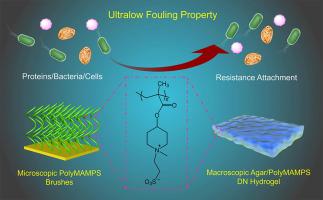Journal of Colloid and Interface Science ( IF 9.4 ) Pub Date : 2020-06-03 , DOI: 10.1016/j.jcis.2020.05.122 Dong Zhang , Baiping Ren , Yanxian Zhang , Yonglan Liu , Hong Chen , Shengwei Xiao , Yung Chang , Jintao Yang , Jie Zheng

|
Hypothesis
Polyzwitterions as a promising class of materials are often used to construct antifouling surfaces with optimized conformation and compositions for a wide variety of antifouling applications. While numerous zwitterionic polymers have been identified for their antifouling capacity, the exact relationship among molecular structure, surface hydration property, and antifouling performance of zwitterionic polymers at different scales still remains elusive.
Experiments
we first designed and synthesized a new zwitterionic monomer of 3-(4-(methacryloyloxy)-1-methylpiperidin-1-ium-1-yl)-propane-1-sulfonate (MAMPS), then used MAMPS monomers to fabricate into homogenous polymer brushes on Au substrate using SI-ATRP and heterogeneous double-network (DN) hydrogels combining with Agar network via one-pot, heating-cooling-photopolymerization method, and finally evaluated their antifouling ability to resist the adsorption of protein/cell/bacteria on the two different polymer forms at microscopic and macroscopic scales.
Findings
For microscopic polyMAMPS brushes, they exhibited excellent resistance to nonspecific protein adsorption from both undiluted blood serum/plasma (0.3–5 ng/cm2), cell adhesion up to 3 days, and clinically relevant bacterial attachment for 72 h at the optimal film thicknesses of 20–40 nm. For macroscopic Agar/polyMAMPS DN hydrogels, they also exhibited approximately 96% less protein adhesion than tissue culture polystyrene (TCPS). Different structured materials consisting of polyMAMPS at both micro- and macro-scales demonstrate its excellent, intrinsic antifouling property, which could be related to their highly water binding character of zwitterionic groups. PolyMAMPS materials, alternative to commonly used poly(sulfobetaine methacrylate) (polySBMA) and poly(carboxybetaine methacrylate) (polyCBMA) zwitterions, hold great promise for antifouling designs and applications.
中文翻译:

具有超低结垢特性的微观和宏观结构的两性离子聚合物。
假设
聚两性离子作为一种有前途的材料,通常用于构建防污表面,该防污表面具有优化的构型和组成,可用于各种防污应用。尽管已经鉴定出许多两性离子聚合物的防污能力,但是在不同规模下两性离子聚合物的分子结构,表面水化性质和防污性能之间的确切关系仍然难以捉摸。
实验
我们首先设计并合成了一种新型的3-(4-(甲基丙烯酰氧基)-1-甲基哌啶-1-基-1-基)-丙烷-1-磺酸盐(MAMPS)的两性离子单体,然后使用MAMPS单体制备均质聚合物使用一锅,加热-冷却-光聚合方法,使用SI-ATRP和异质双网络(DN)水凝胶与琼脂网络结合,在Au基底上刷涂,最后评估了它们在蛋白质上的抗污垢能力,以抵抗蛋白质/细胞/细菌的吸附两种不同的聚合物分别在微观和宏观尺度上形成。
发现
对于显微polyMAMPS刷子,它们对未稀释的血清/血浆(0.3-5 ng / cm 2)的非特异性蛋白质吸附表现出出色的抵抗力),长达3天的细胞粘附以及在20–40 nm的最佳膜厚度下72小时的临床相关细菌附着。对于宏观琼脂/ polyMAMPS DN水凝胶,与组织培养聚苯乙烯(TCPS)相比,它们的蛋白质附着力也低约96%。在微观和宏观尺度上由polyMAMPS组成的不同结构材料均显示出其优异的固有防污性能,这可能与两性离子基团的高水结合特性有关。PolyMAMPS材料可替代常用的聚甲基丙烯酸磺基甜菜碱(polySBMA)和聚甲基丙烯酸羧基甜菜碱(polyCBMA)两性离子,在防污设计和应用方面具有广阔的前景。































 京公网安备 11010802027423号
京公网安备 11010802027423号